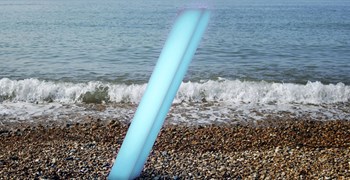In search of the Holigost: Could archaeologists be about to rediscover Henry V's warship?
This article originally appeared on Culture24.
More than 40 years after Henry V’s Grace Dieu was found, sister ship the Holigost could be about to surface in a Hampshire medieval breaker’s yard
 Henry V's Holigost may be submerged in Hampshire© James O Davies
Henry V's Holigost may be submerged in Hampshire© James O DaviesDr Ian Friel, a historian and expert advisor to Historic England, singled out the wreck as the possible skeleton of the 600-year-old warship while working for the former Archaeological Research Centre. Historic England is now investigating and preparing to protect what could be the remains of a ship once decorated with symbols of the king’s religious and political beliefs, including the French motto, une sanz pluis, meaning that the monarch should rule alone.
“In my opinion, further research leading to the rediscovery of the Holigost would be even more important than the identification of the Grace Dieu in the 1930s,” believes Dr Friel, who says he is “utterly delighted” at the decision to protect the site.
 A depiction of the royal fleet of King Edward I of England, from Jean de Wavrin's 'Chronicles of England', Bruges (circa 1470-80)© British Library Board, Royal MS
A depiction of the royal fleet of King Edward I of England, from Jean de Wavrin's 'Chronicles of England', Bruges (circa 1470-80)© British Library Board, Royal MSHenry’s naming of his four key ships built between 1415 and 1420 - the Trinity Royal, the Jesus, the Grace Dieu and the Holigost - reflected his religious devotion.
“They were the personal property of King Henry V and the closest thing he had to a state navy,” says Dr Friel.
 A depiction of a carrack carrying John of Gaunt to Lisbon© British Library Board, Royal MS
A depiction of a carrack carrying John of Gaunt to Lisbon© British Library Board, Royal MS“The Grace Dieu was a magnificent vessel and the largest of Henry’s ships. It is the only one of Henry V’s to have been found until now.”
After the king ordered the Holigost to be rebuilt, the ship was delivered to the ship’s first and only master, Jordan Bronyng, on November 14 1415. At the time, large numbers of guns were still not carried on warships, but the Holigost was the most heavily armed of Henry’s fleet, carrying seven breech-loader guns and eventually receiving a 4.8-metre anchor, large enough to be given the name Marie Tynktawe.
 © British Library Board, Royal MS
© British Library Board, Royal MS“By 1423 we know the Holigost was leaking badly. A diver named Davy Owen was sent to swim underwater and block up cracks in the hull.
“This may well be the earliest-recorded instance of this kind of diving work in England.
 A French Medieval fleet, from Froissart's Chronicles, Bruges (circa 1470-75)© British Library Board, Harley MS
A French Medieval fleet, from Froissart's Chronicles, Bruges (circa 1470-75)© British Library Board, Harley MS“It became a labour of love; a contemporary account records him working ‘night and day’ to combat leaks and pump out water.
“During the winter months of 1430 Brownyng stopped his work – this must mark the government’s effective abandonment of any hope of rebuilding the Holigost.
 Heraldic arms on a flagship, from 'A History of the Conquest of the Canary Islands', Paris (circa 1420-30)© British Library Board, Egerton
Heraldic arms on a flagship, from 'A History of the Conquest of the Canary Islands', Paris (circa 1420-30)© British Library Board, Egerton“By 1452 the ship was described as ‘sunk in the sea and in this way broken’.”
Duncan Wilson, the Chief Executive of Historic England, says the “huge national significance” of the Battle of Agincourt has spurred the group to realise the “full potential” of the discovery.
 Medieval fleet from Edwards IV's 'Descent from Rollo and The Romance of the Three Kings' Sons, London (circa 1475-85)© British Library Board, Harley MS
Medieval fleet from Edwards IV's 'Descent from Rollo and The Romance of the Three Kings' Sons, London (circa 1475-85)© British Library Board, Harley MS“It holds the possibility of fascinating revelations in the months and years to come.”
The Holigost
 An artist's impression of the Holigost© Historic England / John Vallender
An artist's impression of the Holigost© Historic England / John Vallender- The ship joined the royal fleet on November 17 1415 and took part in operations between 1416 and 1420, including two of the most significant naval battles of the Hundred Years War.
- In 1416 it had a crew of 200, but also carried large numbers of soldiers to war – as many as 240 in one patrol.
- Conditions aboard were likely to have been crowded and unpleasant before battle even commenced. The men were supplied with weaponry and armour, including 14 bows and more than 2,000 arrows, six crossbows and a variety of helmets and hand weapons such as poleaxes and spears.
- The two specifically naval weapons carried by the ship were gads and grapnels (hooks). Gads were iron spears thrown on to the sailors and soldiers on the deck of an enemy vessel. Falling over 100 feet, these fearsome weapons could penetrate metal plate armour. Medieval sea battles often ended with boarding actions fought between individual ships. Grapnels were used by the crew of the attacking ship to secure their vessel to an opponent’s warship.
- On August 15 1415 the Holigost was serving as the flagship of the English fleet with the Duke of Bedford in command. The ship suffered significant damage during the long and bloody siege of Harfleur. The enemy seemed to have boarded the ship and made serious efforts to bring down the mainmast. In the skirmish a grapnel was lost.
- The following year, on July 25 1417, the Holigost went into battle once again as part of an English force fighting a French-led fleet off the Chef de Caux at the mouth of the Seine. This battle broke the back of French seapower; less than a week later Henry V invaded France for the second time.
- The ship weighed 75-760 tons and was originally the Santa Clara – Saint Claire, of Assisi, an Italian Saint and early follower of Saint Francis of Assisi.
- It first belonged to the Queen of Spain, but was captured in late 1413 or early 1414 by a ship of William Soper, one of Henry V's key admin men, before being rebuilt as the Holigost.
- It was docked at Burseldon (Hamble) in 1426 and is last mentioned in records from 1447-52.
What do you think? Leave a comment below.
Three museums to see naval history in
Historic Dockyard Chatham
Make rope on the Victorian Ropery Tour; be gripped by stories of life aboard three historic warships, see big ‘things’ in 3 Slip The BIG Space and hear of heroic stories in the RNLI Historic Lifeboat Collection.
HMS Victory at Portsmouth Historic Dockyard
The world’s oldest commissioned warship, HMS Victory, still has a full-time Royal Navy crew today. She is now the flagship of the Second Sea Lord and Commander in Chief Naval Home Command, lying in No 2 Dry Dock at Portsmouth Naval Base, Portsmouth, England.
John Paul Jones Museum, Dumfries
The National Office and Museum are situated in Sparrow's Nest and a most attractive display of relics and memorablilia has been gathered together by members of the Royal Naval Patrol Service Association who devote their spare time to making this a unique and brightly-decorated meeting place.












